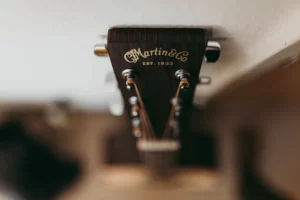History
While getting into Martin LX1 Little Martin Review, let’s take a trip back in time…
Mr. CF Martin founded his guitar production enterprise in New York City in 1833. To put that into context, he was born during the presidency of George Washington. But instead, how things have evolved since politics was done mainly by honest men.
Martin is among the world’s most well-known and renowned acoustic guitar manufacturers. Its facilities are in Pennsylvania. However, most of its products are manufactured in Mexico. They ruled their manners in such electric guitars for several years until 1946. Then Bob Taylor arranged Taylor guitars, and the struggle for quality began.
Fender came up, but they never attained the same level of excellence in their acoustic line. Gibson, too, dabbled with acoustics and created several attractive instruments, such as the J200. Epiphone also made a fantastic dreadnought guitar, which the Beatles frequently played.
The remainder dropped out of contention due to their firms’ concentration on other items. Martin was on an acoustic guitar mission, except for a few mandolins and ukuleles. They desired to be king of the crown of the ‘flattops.’ “Here comes the old flattop…”
The big three was formed when some other producer entered the big two. Yamaha was relatively late to the party, but they made a significant contribution that prompted Martin and Taylor to improve. There’s nothing wrong with it.
Nowadays, all three are to be members of an exclusive group. Some include Seagull, Gibson, and now Fender and Ibanez in this category. However, most people think there are three major players in the acoustic industry.
We’ll look at the Little Martin guitar or the Little Martin LX1. A smaller-sized instrument. So, how does it compare to its bigger cousins?
Overview
Martin produces a line of tiny, cheap guitars known as the Travel series. They are, nevertheless, suitable for a range of different applications. A full-size instrument may be difficult to use if you’re an adult with tiny hands. This instrument will take care of it. Another option is to use it as a starting guitar for a new learner. A Martin guitar is one of the best methods to start a new player’s career.
It’s a 23-inch scale instrument that is 18 inches by 7 inches by 39 inches in size, a little more than eight pounds. It has to rank among the best guitars in its market class. Martin’s quality, tone, and usability are all standard. This guitar is produced in Mexico and incorporates many of the best qualities of Martin guitars.
Build
This ‘Little Martin’ is precisely what the name implies. It is a 3/4-size variation of a full-size Martin. In fact, this is the tiniest guitar in the Martin collection. It has a classic non-cutaway design.
People frequently ask why certain guitars have cutaways while others have not. There is no definitive answer; it is a matter of design and manufacturers’ thoughts. However, there are various sound difficulties. Guitars without a cutaway often have a more prominent bottom end and more volume. In general, a full sound.
Neck Style
There are times when certain corners were there while creating an economical guitar. Somewhere, costs must be cut. That is not a concern because the producers do not try to conceal it.
Martin has said categorically that this model has a stratum-bound neck. Smaller bits of wood will not be wasted as typically in this procedure. The strata bonding multi-laminating method yields a functional and sturdy wood without the high cost of a genuine mahogany or maple neck.
Consequently, there is a sturdy neck, which is subsequently colored to give it a lovely finish.
Martin employs this approach on the LX1 and several other lower-priced instruments. It does enable those who would not otherwise be able to purchase a Martin to do so. The fingerboard on the 20-fret neck is Richlite, and 14 chords are easily accessible; the remaining frets require more work.
A Mortise and Tenon connection system connects the neck to the body. The neck has a slightly low oval form that makes it student-friendly. The fret markers are dots on the top portion of the fretboard. The neck is simple to hold and has a nice feel in the palm, thanks to the reduced design.
Sound
Designing a 34-size guitar without a cutaway is a smart idea. It does restrict access to the fingerboard’s upper reaches but at the sacrifice of tone. We like the sound better.
Acoustic guitars get the majority of their sound from the body, particularly the size of the body. There are additional considerations, such as the material of wood used, but the scope and form of the body will mainly define the sound.
A more petite body, such as the Little Martin lx1, is to lose some of the thickness and delicacy of sound. A pullout will reduce the sound even further. A lack of cutaway will enhance the bottom end and typically give you a richer tone.
Wood – Spruce & Mahogany
Mahogany laminate is on the side and back. The top is of solid Sitka spruce. Two kinds of wood are known for their excellent sound that works well together. The spruce’s clean top tone balances mahogany’s warm richness.
A Style X cross, top supporting design is used in the body. This adds stability to the body and improves the sound generated. The bracing will govern how the tops of the guitar vibrations in response to sound. Without bracing, the instrument would vibrate out of control. This would have a significant impact on the sound quality generated.
In many respects, the bracing contributes to the purity of the music you perceive. This brace technique on the Little Martin may also be seen on much more expensive guitars.
The body style is conventional and not at all showy, which is an excellent thing. The top has a great gloss, and the Mahogany sides and the back aesthetically match it. Around the soundhole is a beautiful, modest design.
Hardware
Martin has never cut shortcuts in this area. Martin shut backing nickel machine heads may be found above the headstock. To keep it in tune, you’ll need a high-quality tuner.
A decent tuner only tightens up when you are tweaking the strings. If winders begin to tighten excessively, the tuners’ quality may suffer – no such issues with these tuners. The turning motion is smooth and precise.
The nut and saddle are both constructed of white Corian and are compensated. A compensated saddle has grooves for the upper E, B, and G frequencies. This improves intonation accuracy by altering string length, which balances for notes played in higher registers. A non-compensated saddle lacks grooves in the saddle. It features a Richlite bridge with white end pins. It is set with Martin SP strings.
How Does It Work?
There is little doubt that the Little Martin LX1 is a delight to play. It suits the bill no matter what level of gamer you are. It is a fantastic alternative for an expert musician looking for a ‘travel guitar.’ It is smaller, lighter, and easier to transport and fits in airline overhead compartments.
There is also friendly equipment around the house for easygoing practice. It’s quite easy to play and requires minimal effort. However, for a beginner, there is everything. The first step toward making it seem simple is a neck in good shape, but the action may be adjusted low, thereby there is no need to struggle. The nicely placed strings are forgiving, as a result.
Pros
- Brilliant resonance and sustain
- Tone is balanced
- High-quality build & durable
- Easy to play and transport
Cons
- The volume and bass level is lower than on a complete acoustic guitar.
- Lack of fretboard markers on the frets, but they are down the neck.
Conclusion
In this Martin LX1 review, you could be browsing for a guitar for a beginner or someone with small hands. You may only want an instrument to keep at home for occasional recreation. As to the reason, it will take a lot of work to find a more potent tool.
The price is one thing to remember when shopping for a Martin guitar. There will be less expensive brands available. However, they will be less excellent than the other industrial class acts and the prices for those brands will be comparable. Overall, the Little Martin LX1 is undoubtedly a class act worth the money and includes a well-cushioned gig.







